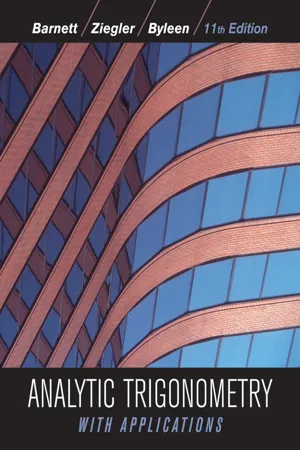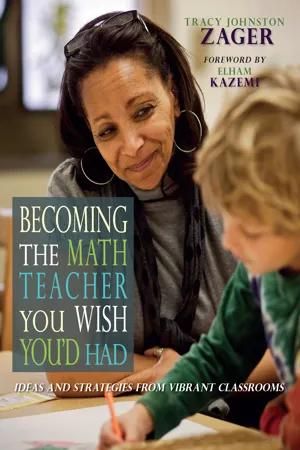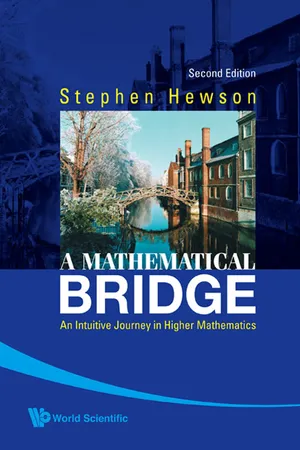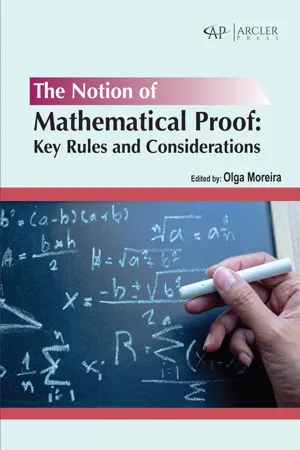Mathematics
Proving an Identity
Proving an identity in mathematics involves showing that two mathematical expressions are equivalent for all values of the variables involved. This is typically done by manipulating one expression until it is transformed into the other expression, using a series of algebraic steps that are justified by the properties of arithmetic and algebra.
Written by Perlego with AI-assistance
Related key terms
1 of 5
6 Key excerpts on "Proving an Identity"
- eBook - PDF
- Raymond A. Barnett, Michael R. Ziegler, Karl E. Byleen(Authors)
- 2012(Publication Date)
- Wiley(Publisher)
But to verify that it is an identity, we must prove that the equation is satisfied by all values of the variables for which both sides of the equation are defined. In this section we will discuss techniques for verifying trigonometric identities. We will also show that a graphing calculator can be helpful in demonstrating that certain equations are not identities. ■ ■ Verifying Identities We will now verify (prove) some given trigonometric identities; this process will be helpful to you if you want to convert a trigonometric expression into a form that may be more useful. The following examples illustrate some of the techniques used to establish certain identities. To become proficient in the process, it is important that you work many problems on your own. EXAMPLE 1 Identity Verification Verify the identity: Use a reciprocal identity. Use an identity for negatives. Use algebra. Use a reciprocal identity. Right side ■ Matched Problem 1 Verify the identity: ■ EXAMPLE 2 Identity Verification Verify the identity: Use a quotient identity. Use algebra. Use a Pythagorean identity. Use a reciprocal identity. Right side Key Algebraic Steps: ■ a b a + b = a 2 b + b = a 2 + b 2 b = sec x = 1 cos x = sin 2 x + cos 2 x cos x = sin x cos x sin x + cos x Left side = tan x sin x + cos x tan x sin x + cos x = sec x sec( - x) = sec x = - csc x = - 1 sin x = 1 - sin x = 1 sin( - x) Left side = csc( - x) csc( - x) = - csc x 236 4 IDENTITIES To verify an identity, start with the expression on one side and, through a sequence of valid steps involving the use of known identities or algebraic manipulation, convert that expression into the expression on the other side. VERIFYING AN IDENTITY Verification Verification Matched Problem 2 Verify the identity: ■ To verify an identity, proceed from one side to the other, making sure all steps are reversible. Even though there is no fixed method of verification that works for all identities, there are certain steps that help in many cases. - eBook - PDF
- Ron Larson(Author)
- 2017(Publication Date)
- Cengage Learning EMEA(Publisher)
When you are finding the values of the variable for which the equation is true, you are solving the equation. On the other hand, an equation that is true for all real values in the domain of the variable is an identity. For example, the familiar equation sin 2 x = 1 - cos 2 x Identity is true for all real numbers x. So, it is an identity. Although there are similarities, verifying that a trigonometric equation is an identity is quite different from solving an equation. There is no well-defined set of rules to follow in verifying trigonometric identities, the process is best learned through practice. Guidelines for Verifying Trigonometric Identities 1. Work with one side of the equation at a time. It is often better to work with the more complicated side first. 2. Look for opportunities to factor an expression, add fractions, square a binomial, or create a monomial denominator. 3. Look for opportunities to use the fundamental identities. Note which functions are in the final expression you want. Sines and cosines pair up well, as do secants and tangents, and cosecants and cotangents. 4. When the preceding guidelines do not help, try converting all terms to sines and cosines. 5. Always try something. Even making an attempt that leads to a dead end can provide insight. Verifying trigonometric identities is a useful process when you need to convert a trigonometric expression into a form that is more useful algebraically. When you verify an identity, you cannot assume that the two sides of the equation are equal because you are trying to verify that they are equal. As a result, when verifying identities, you cannot use operations such as adding the same quantity to each side of the equation or cross multiplication. Trigonometric identities enable you to rewrite trigonometric equations that model real-life situations. - eBook - ePub
Becoming the Math Teacher You Wish You'd Had
Ideas and Strategies from Vibrant Classrooms
- Tracy Johnston Zager(Author)
- 2023(Publication Date)
- Routledge(Publisher)
proving is a verb—and that we shouldn’t get wrapped up in creating proofs as products—Math Celebration is a creative way to communicate with families and give them insight into the powerful thinking and working their children are doing in school each day. Mark said the most common response he heard from family members was, “I wish I had learned math this way!”Proof and Equity
Proving is asocial process, situated in social contexts. Mathematicians use their reasoning and knowledge to prove mathematical ideas to one another at conferences, on chalkboards, over coffee, and in journals. We’ve seen that young mathematicians can also use their reasoning and knowledge to prove mathematical ideas to one another, with our guidance. Because people do all of this proving in social contexts, we can be sure that they—we—are influenced by fads, assumptions, and preferences. Pólya said, “Mathematics in the making resembles any other human knowledge in the making” (1954b, vi). The human act of proving is complex, and so it shall be in our classrooms!But there’s a downside, too. For far too long, we have been biased toward a certain type of mathematical thinking, couched a certain way, from a certain type of student. We hold deeply ingrained stereotypes about ideal math students: typically, white and Asian boys, “logical” thinkers, fast memorizers, confident calculators. How many students are we pushing out of mathematics because of these stereotypes? Far too many, as evidenced by the persistent underrepresentation of African American, Latino/a, and Native American students; of emergent bilingual students; and of girls of all ethnicities in advanced math classes, mathematics majors, and STEM professions. - eBook - PDF
How to Read and Do Proofs
An Introduction to Mathematical Thought Processes
- Daniel Solow(Author)
- 2013(Publication Date)
- Wiley(Publisher)
1.2 WHAT IS A PROOF? A proof is a convincing argument expressed in the language of mathematics that a statement is true. All of the foregoing words are important to your understanding of what a proof is. For example, in mathematics, a statement is a sentence that is either true or false. Some examples follow: 1. Two parallel lines in a plane have the same slope. 2. 1 = 0. 3. The real number x > 0 (x is not greater than 0). 4. There is an angle t such that cos(t) = t. Observe that statement (1) is true, (2) is false, and (3) is either true or false, depending on the value of a variable. It is perhaps not as obvious that statement (4) is also true. Furthermore, a statement that appears to be true can, in fact, be false. This is why it is necessary to do proofs—you will know that a statement is true only when 1.2 WHAT IS A PROOF? 3 cos(t) -π t π t 0 -π/ 2 π/ 2 Fig. 1.1 A proof that there is an angle t such that cos(t) = t. you have proved it to be true. In this and other books, proofs are often given for what seem to be obviously true statements. One reason for doing so is to provide examples that are easy to follow so that you can eventually prove more difficult statements. A proof should contain enough mathematical details to be convincing to the person(s) to whom the proof is addressed. A proof of statement (4) that is meant to convince a mathematics professor might consist of nothing more than Figure 1.1; whereas a proof directed toward a high school student would require more details, perhaps even the definition of cosine. Your proofs should contain enough details to be convincing to someone else at your own mathematical level (for example, a classmate). It is the lack of sufficient detail that often makes a proof difficult to read and understand. One objective of this book is to teach you to decipher “condensed” proofs that typically appear in textbooks and other mathematical literature. - eBook - PDF
A Mathematical Bridge
An Intuitive Journey in Higher Mathematics
- Stephen Hewson(Author)
- 2009(Publication Date)
- WSPC(Publisher)
We can use various 11 In formal logic AND is often referred to as conjunction with the symbol ∧ ; OR is likewise referred to as disjunction with the symbol ∨ and NOT is called negation and given the symbol ∼ . In addition, they may all also be described using combinations of NOT and AND. For example, P OR Q is equivalent to NOT(NOT( P ) AND NOT( Q )). However, despite this non-minimality the operations of AND, OR and ⇒ have very clear intuitive meanings and these are the most regularly used operations in proofs. 22 A Mathematical Bridge combinations of true, false, AND, OR, NOT and implication applied to the axioms in the development of proofs . This, in a nutshell, is the process of mathematics. 1.3.4 Proof Proving a result in mathematics can be quite similar to the process of a criminal trial. The mathematician wishes to prove a certain result to be true; the prosecution lawyer wishes to prove that the defendant is guilty of a certain crime. In both cases, evidence for the result is collected and a case for the result is then logically constructed. However, the meaning of proof in the two cases is very different: in an English trial of law a defendant is proven guilty of a crime if the evidence provided indicates guilt ‘beyond all reasonable doubt’; in mathematics, a result is proved true if evidence is provided ‘beyond all doubt’. A mathematical proof is simply any logical argument which demonstrates the truth of the result beyond doubt: there can be no logical holes, uncertainties or ambiguities in a mathematical proof 12 . Whilst mathematicians might believe that a result is true, until a proof is provided, the result remains conjecture . Sometimes interesting conjectures occupy mathematicians for centuries until proofs are found or the result is shown to be false. Many conjectures are described throughout this book; several play a key part in the history of mathematics. - Olga Moreira(Author)
- 2023(Publication Date)
- Arcler Press(Publisher)
Keywords: Teaching abstract algebra, basic components, mathematical proof process, teaching proof INTRODUCTION The aims of mathematics are to understand the rules on which numbers, algebra, and geometry are based; to find new and non-routine ways in these systems; and to explain new situations that are encountered. The world of mathematics is a world of ideas, insights, and discoveries, which will not be realized by people who are only interested in how to separate a function, and it is necessary to use mathematical proof and abstraction to enter this world (Goldberg, 2002). A mathematical proof, which is far more than just one or several examples supporting a mathematical statement (Derek, 2011), is a logical explanation of why a mathematical statement is true (Altıparmak & Öziş, 2005). The best proof is the one that helps understand the proved theorem by showing not only that it is true but also why it is true (Hanna, 2000). The Purpose of the Study Proofs constitute the basis of mathematics (CadwalladerOlsker, 2011; Sarı, 2011). Therefore, many studies have been conducted on mathematical proofs. However, the mathematical proof process was not presented step by step in any study as in this study. Abstract Algebra is one of the most important course of mathematics and mathematics education at the university level. According to Agustyaningrum, Husna, Hanggara, Abadi and Mahmudi (2020), abstract algebra is full of definitions and theorems which all require proof. Therefore, the students need to understand every definition and theorem they learn and be able to organize the concepts needed to proving theorems. For that to be possible, students should have the ability to organize the required information for proving theorems in abstract algebra. This requires them to have an idea about the structure and stages of the proofs. Organizing the Mathematical Proof Process with the Help of Basic ...
Index pages curate the most relevant extracts from our library of academic textbooks. They’ve been created using an in-house natural language model (NLM), each adding context and meaning to key research topics.





